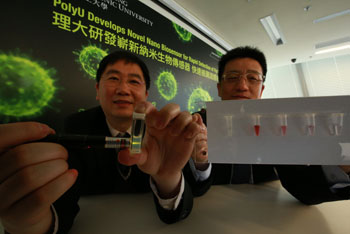Innovative Nano-Biosensor Developed for Rapid Detection of Viruses
By LabMedica International staff writers
Posted on 23 Mar 2016
Scientists have invented a compact, easy-to-use biosensor for rapid, sensitive detection of flu and other viruses by utilizing the optical method of upconversion luminescence resonance energy transfer (LRET).Posted on 23 Mar 2016
The new method, invented by researchers at the Hong Kong Polytechnic University (PolyU; Hong Kong), involves simple operational procedures that significantly reduce testing time from around 1–3 days to 2–3 hours, making it over 10 times quicker than traditional clinical methods. Furthermore, it is a low-cost test—about 80% lower than traditional tests, and the technology can be widely used to detect different types of viruses

Image: A novel nano-biosensor has been developed for lower-cost, rapid virus detection based on upconversion luminescence resonance energy transfer (LRET) technology and DNA oligo hybridization. Testing takes only 2–3 hours, about 10x faster traditional clinical methods (Photo courtesy of the Hong Kong Polytechnic University).
RT-PCR is expensive and time-consuming while the sensitivity for ELISA is relatively low. Such limitations make these methods difficult for use in front-line and on-site virus detection. This challenge paved the way for the researchers to develop a new biosensor based on the luminescent technique.
The luminescent technique operates analogous to two matching pieces of magnet with attraction force. It involves the development of upconversion nanoparticles (UCNPs) conjugated with an oligo probe whose DNA base pairs are complementary with that of the gold nanoparticles (AuNPs) flu virus oligo. Given the complementarity, the two oligos undergo DNA-DNA hybridization. Upon being illuminated by a portable near-infrared laser pen, the UCNPs emit eye-visible green light while the AuNPs would absorb the green light. One can easily quantify the concentration of the targeted flu virus by measuring the decrease in green light intensity.
Initially, the researchers used upconversion LRET for ultrasensitive virus detection in liquid-phase system. The team then further improved the sensitivity by using a solid-phased nanoporous membrane system (NAAO). As NAAO membrane consists of many hollow channels, it allows more space for oligo hybridization to take place, increasing sensitivity by over 10 folds compared to the liquid-phase system, based on detection using inactivated virus samples.
The new biosensor does not require expensive instruments and sophisticated operational skills, and has sensitivity comparable to traditional clinical methods. In comparison to conventional downconversion luminescent technique, it causes low damage to genetic materials and does not induce background fluorescence. In addition, a complementary probe can be designed to target detection of any virus with known genetic sequence. In other words, the new method can be widely used for the detection of different types of viruses simply by modifying the UCNPs capture probe.
The team will continue to enhance the biosensor for virus detection, including increasing sensitivity and specificity, and developing a matrix for multiplex detection of multiple flu viruses on a single testing platform.
The related results have been recently published in the two nanomaterial research journals ACS Nano and Small.
Related Links:
The Hong Kong Polytechnic University













